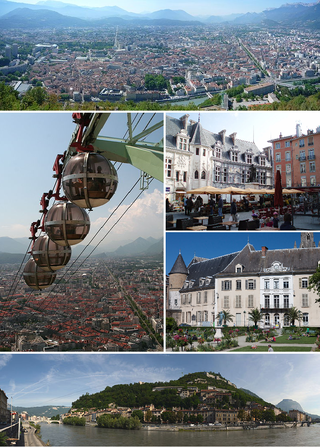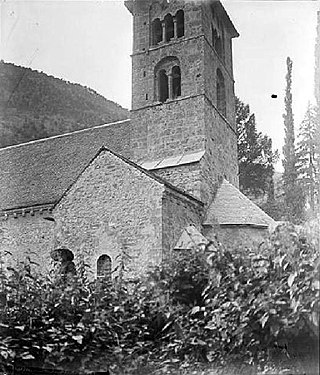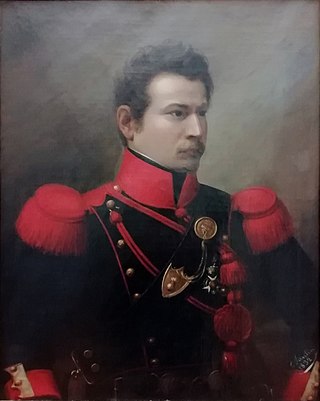
Grenoble is the prefecture and largest city of the Isère department in the Auvergne-Rhône-Alpes region of southeastern France. It was the capital of the Dauphiné historical province and lies where the river Drac flows into the Isère at the foot of the French Alps.

The Isère is a river in the Auvergne-Rhône-Alpes region of southeastern France. Its source, a glacier known as the Sources de l'Isère, lies in the Vanoise National Park in the Graian Alps of Savoie, near the ski resort in Val-d'Isère on the border with Italy. An important left-bank tributary of the Rhône, the Isère merges with it a few kilometers north of Valence.

The Romanche is a 78.3-kilometre (48.7 mi) mountain river in southeastern France. It is a right tributary of the Drac, itself a tributary of the Isère. Its drainage basin is 1,221 km2 (471 sq mi).

The Drac is a 130-kilometre (81 mi) long river in southeastern France. It is a left tributary of the river Isère. It is formed at the confluence of the Drac Noir and the Drac Blanc, which both rise in the southern part of the Massif des Écrins, high in the French Alps. It flows through several reservoirs on its course, including the Lac de Monteynard-Avignonet. It flows into the Isère at Grenoble. Its major tributary is the Romanche.

Le Bourg-d'Oisans is a commune in the Isère department in southeastern France.
The following is a list of the 29 cantons of the Isère department, in France, following the French canton reorganisation which came into effect in March 2015:

Champ-sur-Drac is a commune in the Isère department in southeastern France. It is situated at the foot of the Alps, at the confluence of the Romanche and the Drac. Its population was 3,339 in 2021. It is part of the Grenoble urban unit (agglomeration).

Belledonne is a mountain range in the Dauphiné Alps in southeast France. The southern end of the range forms the eastern wall of the mountains that surround the city of Grenoble.

Mayres-Savel is a commune in the Isère department in southeastern France. It borders the communes of Marcieu to the west, Saint-Arey to the east and Prunières to the north.

Auris is a commune in the Isère department in the Auvergne-Rhône-Alpes region of south-eastern France.

Vaujany is a commune in the canton of Oisans-Romanche, in the Isère department in southeastern France. The village is picturesque, with excellent views of the Grand Galbert mountain at the head of the valley.

Sassenage is a commune in the Isère department in southeastern France, lying in the north-west of the Grenoble urban area. Its historic centre is on the valley floor at the foot of a large cliff face, with housing also stretching up the lower slopes of the Vercors massif and more recent developments towards Fontaine and the Drac river.

Biviers is a commune in the Isère département in southeastern France.

Avignonet is a commune in the Isère department in the Auvergne-Rhône-Alpes region of south-eastern France.

Livet-et-Gavet is a commune in the Isère department in southeastern France.

Victor Sappey, also known as Pierre-Victor Sappey, was a French sculptor.
The Isère-Drac-Romanche Departmental Association is a public administrative establishment in France formed by the Conseil d'État in 1936. Its purpose is to maintain the system of flood-risk protection in the plains of the Isère, Drac, and Romanche rivers by preserving the integrity of embankments and their associated works. The organization performs all research and labor necessary for their preservation and keeps the system under constant surveillance in order to guarantee its efficiency in protecting the land and property at stake behind the embankments.

The flood of Grenoble in 1219 was a natural disaster that took place in the plain of Grenoble on the night of 14 to 15 September 1219. It happened from the rupture of a natural dam near the village, of "Saint-Laurent-du-Lac."that had formed 28 year prior about 30 kilometers southeast of Grenoble, in the Romanch valley.

During the Second World War, the Oisans maquis was an important center for the French Resistance, in the Oisans region between the Belledonne range and Grenoble to the north, the Grandes Rousses massif of the Alps and the Croix de Fer pass to the east, the Drac valley to the west and the Barre des Écrins and the Provencal Alps to the south.

The Sisco is a small coastal stream in the department of Haute-Corse, Corsica, France. It enters the Tyrrhenian Sea from the east of the Cap Corse peninsula.


















